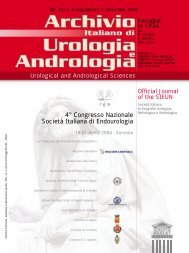7° Congresso Nazionale
7° Congresso Nazionale
7° Congresso Nazionale
Create successful ePaper yourself
Turn your PDF publications into a flip-book with our unique Google optimized e-Paper software.
The role of fluorescent cystoscopy<br />
with hexaminolevulinate in the diagnosis<br />
of bladder cancer.<br />
A. Volpe, F. Porpiglia, M. Billia, R.M. Scarpa<br />
Urothelial carcinoma of the bladder is the sixth most common<br />
malignant disease in the world. In 75–85% of cases,<br />
bladder tumors are superficial at first diagnosis. However,<br />
50–70% of patients presenting with superficial bladder<br />
cancer will develop one or several recurrences after initial<br />
treatment with transurethral resection (TUR), while 10-<br />
20% will experience disease progression with infiltration of<br />
the bladder muscle. White light cystoscopy (WLC) and urinary<br />
cytology are the standard methods for detecting bladder<br />
cancer, but their sensitivity and specificity are not completely<br />
satisfactory, leading to a relatively frequent incomplete<br />
detection of primary or recurrent tumors (1,2). Flat<br />
urothelial lesions, such as CIS or urothelial dysplasia, are<br />
particularly difficult to visualize endoscopically with classical<br />
WLC because they are frequently located in unspecifically<br />
inflamed or normal appearing mucosa. Even the use<br />
of random biopsies does not result in a clinically relevant<br />
improvement in the diagnosis of CIS (3). This is particularly<br />
important since CIS is characterized by a higher risk<br />
of progression to muscle invasive disease.<br />
Furthermore, the risk of incomplete removal of tumour tissue<br />
during transurethral resection of bladder tumour<br />
(TURBT) is significant, either by overlooking flat dysplastic<br />
lesions extending from the resected tumour, or tiny papillary<br />
satellite tumours. Tumour remnants were found in up<br />
to over 50% of cases at a second-look resection 4-6 weeks<br />
after a first TURBT (4,5). The tumours that have been<br />
missed during the resection will account for at least part of<br />
the frequent positive cystoscopies 3-6 months after initial<br />
treatment and may be responsible for a decreased survival.<br />
To improve the sensitivity of WLC, especially for CIS, fluorescence<br />
cystoscopy (FC) has been studied extensively in<br />
the last few years (6). FC is a technique of photodynamic<br />
diagnosis (PDD). PDD is based on the interaction between<br />
a fluorochrome with a high selectivity for tumour cells and<br />
light with an appropriate wavelength, which is absorbed by<br />
the fluorochrome and reemitted with a different (longer)<br />
wavelength. Since the early 1990s, 5-aminolaevulinic acid<br />
(5-ALA) has been investigated for the fluorescent detection<br />
of urothelial cancer. ALA is a precursor in the heme biosynthesis<br />
pathway and induces an accumulation of fluorescent<br />
endogenous porphyrins, mainly protoporphyrin IX (PPIX)<br />
in tissues of epithelial origin (7).<br />
The mechanisms that lead to an increased production of<br />
fluorescent PPIX in cancerous tissue are currently not fully<br />
understood. Several theories have been proposed, including<br />
differences in the level of cellular metabolism, structur-<br />
<strong>7°</strong> <strong>Congresso</strong> <strong>Nazionale</strong> Associazione Italiana di Endourologia<br />
Divisione Universitaria di Urologia, ASO San Luigi Gonzaga, Orbassano, Università di Torino<br />
al characteristics of diseased urothelium, inflammation<br />
with consequent increase in permeability to ALA and<br />
hyperproliferation of the urothelium, leading to a cumulative<br />
effect. There are mainly two enzymes in the biosynthesis<br />
of heme considered responsible for a tumour cell-specific<br />
accumulation of PPIX: porphobilinogen deaminase<br />
and ferrochelatase. The former is the rate limiting enzyme<br />
and has been identified in greater concentrations in tumour<br />
tissue. Clinical results with 5-ALA cystoscopy have been<br />
very encouraging. Kriegmair et al. first evaluated the significance<br />
and feasibility of the procedure, comparing endoscopic<br />
findings under white light and fluorescent cystoscopy<br />
and histology. A very high correlation was<br />
observed between biopsies taken from areas with either<br />
negative or positive fluorescence and histological findings.<br />
In particular, a sensitivity of more than 95% and a specificity<br />
of 68.5% was achieved (8). Other series have subsequently<br />
confirmed these findings (9-12). Overall, FC<br />
accounts for an increase in the tumor detection rate<br />
between 18-76% as compared to WLC.<br />
Zaak et al. have the largest experience with 5-ALA FC. In<br />
their series tumors were detected only because of positive<br />
fluorescence in 26.4% of cases. The incidence of CIS and<br />
severe dysplasia in this patient group was 26.9%. Also, in<br />
cases of suspicious cytological findings with negative WLC,<br />
FC was able to considerably increase the tumor detection<br />
rate (7).<br />
In addition to flat urothelial lesions, the high rate of residual<br />
tumor after TUR represents another reason for the high<br />
recurrence rate of bladder tumors after the first resection. A<br />
multicentre, randomized prospective trial including 165<br />
patients was carried out in 1997-98 to investigate whether<br />
FC-guided TURBT is able to reduce the rate of overlooked<br />
tumors. The Authors compared the rate of residual<br />
tumours 10-14 days after initial resection and found that<br />
62% of patients were tumor-free after FC-guided TURBT<br />
vs. 41% of cases after WLC-guided TURBT (p < 0.01).<br />
Therefore, the rate of residual tumor could be reduced significantly<br />
by nearly 40% under fluoroscopic guidance (13).<br />
In another study of 191 patients with superficial bladder<br />
cancer, the residual tumour rate at 5-6 weeks from the initial<br />
resection was 25.2% in the WLC arm versus 4.5% in<br />
the FC arm (p < 0.0001) (14).<br />
Some studies have been also carried out to determine<br />
whether FC-guided TUR is able to increase recurrence free<br />
survival. Initial results showed a clear trend towards lower<br />
recurrence rates in patients who had been resected under<br />
Archivio Italiano di Urologia e Andrologia 2007, 79, 3, Supplemento 1<br />
41



